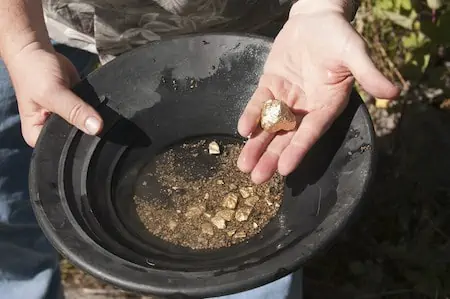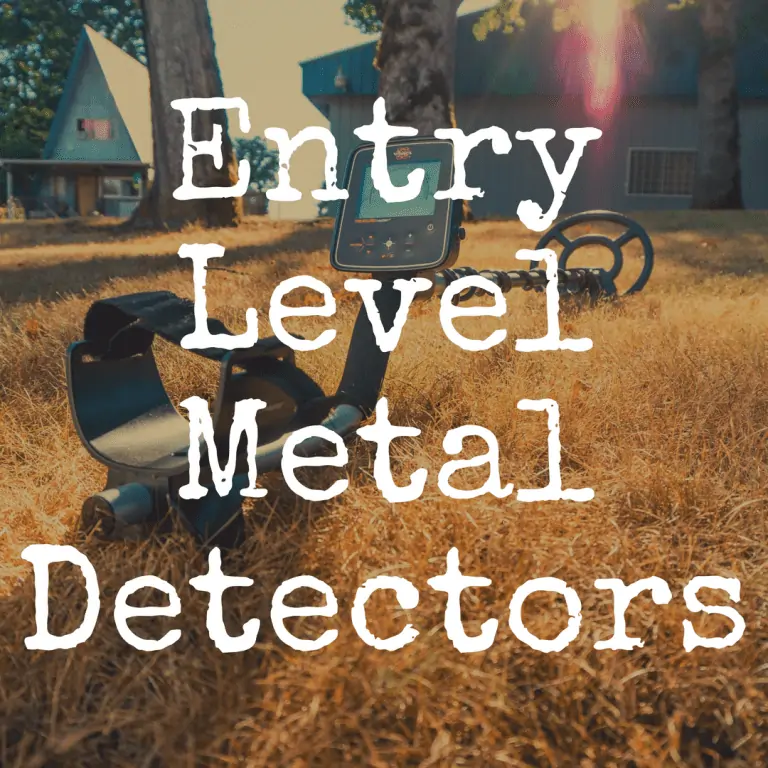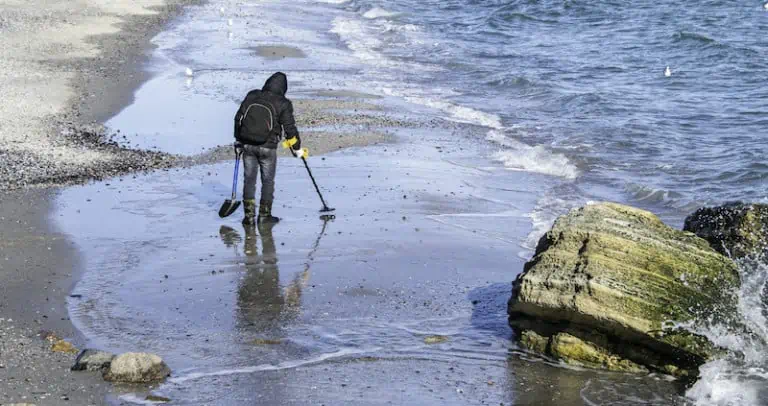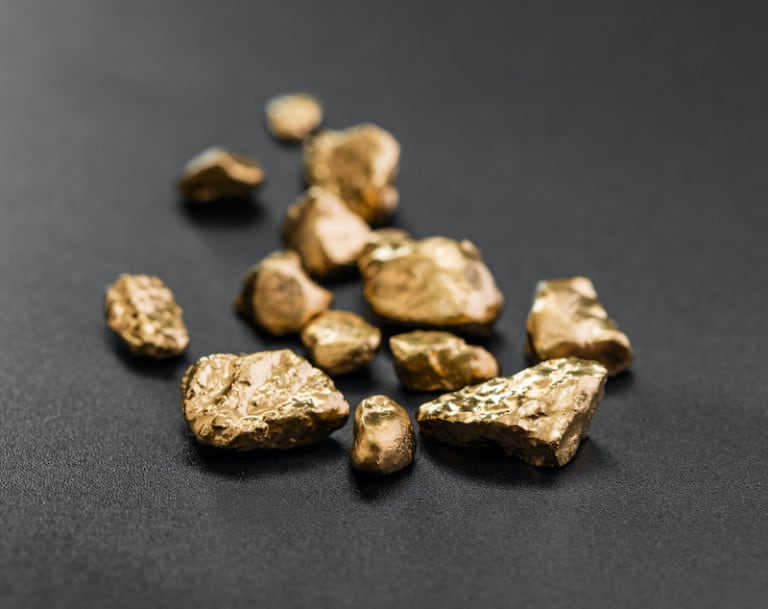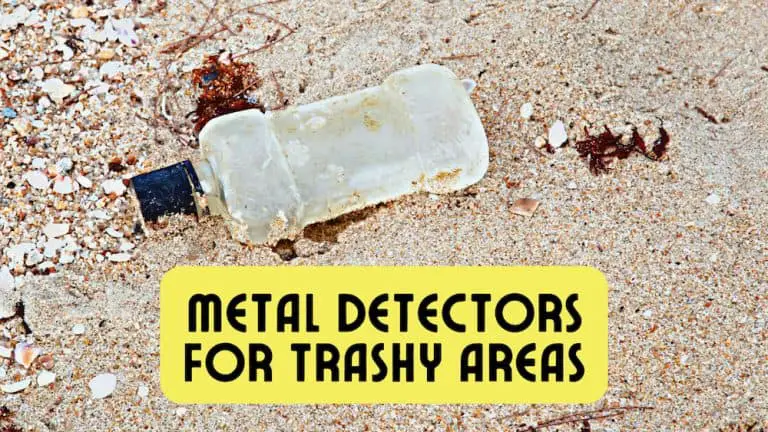50 Ways the Best Gold Metal Detectors in the World Rock
Gold prospecting with a metal detector is an incredibly rewarding hobby, and one that could potentially turn into a huge payday! Many large gold nuggets have been found by metal detectorists in the field. There are some important bits of information to note before heading out to find your treasure.
Below, we will discuss 50 ways gold metal detectors rock, the types of metal detector for gold hunting, search coils, gold bearing soils, etc., and discuss the best gold metal detectors. We will also touch on finding gold nuggets and metal detecting for gold in streams and creeks.
50 Ways the Best Gold Metal Detectors Rock
- They are designed specifically for gold.
- They offer unique learning opportunities.
- You can learn about geology.
- You can learn about history.
- You will learn more about metal detecting.
- They could lead to a HUGE payday!
- They open doors to the wonderful hobby of metal detecting.
- They allow you to get outside and moving around more.
- They have a variety of prices, from very inexpensive to expensive.
- They can be used by newbies or experienced detectorists.
- Some can be used underwater.
- Most have simple to use controls.
- They come in 2 styles: VLF and PI (more about that in the next section).
- They offer a hobby that can be enjoyed by everyone, no matter their age.
- You could find a real gold nugget!
- They are built to compensate for difficult soil conditions.
- Many come with search coil options, so users can customize their detectors to their needs.
- Many come with advanced controls for greater user preference.
- You can look for gold anywhere that it has been previously found with your detector.
- All well-known manufacturers of metal detectors offer gold-specific models.
- If you find enough gold, the machine will literally pay for itself!
- You could help someone find lost gold jewelry with your detector.
- You can look for gold while you vacation, camp, or hike.
- You can find gold that previous prospectors left behind.
- You can join a prospecting or metal detecting club.
- You will never get bored looking for gold!
- A gold metal detector is less expensive than many other hobbies.
- You can get your kids involved in prospecting.
- You can learn about history in your local area.
- You can explore new terrain in areas you would not normally go.
- You will learn more about geology and rock identification while searching for gold.
- You can use a gold detector on beaches to find lost gold jewelry and other treasure.
- Once you find that first piece of gold you will be hooked!
- You could find enough gold to pay for your prospecting trip (and equipment!).
- You will gain a new appreciation for the outdoors and nature.
- You do not have to be in the Gold Rush areas to find gold.
- You may only find flakes of gold, but enough flakes add up!
- If your gold detector is submersible in deep waters, you can shipwreck dive and find lost treasures.
- These detectors typically have the perfect frequency of pulses per second to find gold.
- Metal detecting is gaining popularity among all age groups.
- Using a gold specific metal detector will allow you to search in areas where other metal detectors may fail.
- You can use a gold metal detector in national forests. It is a great hobby for camping!
- You can metal detect on public lands (BLM lands), barring any state, local, or federal restrictions.
- You could help rediscover the past.
- Metal detecting for gold is a great solo activity. Just you and your detector.
- Metal detecting for gold is a fantastic family or friend activity, too! It is fun to involve your whole family, or a group of friends, in your pursuit of gold.
- You can upgrade if you purchase a cheaper gold metal detector.
- The thrill of finding gold never leaves you.
- Finding gold is a tangible investment. Gold prices fluctuate, but it is always a valuable metal.
- You can find many tips of how to find gold, what types of detectors work best in what areas, and metal detecting in general all over the web or in libraries.
Types of Metal Detectors
There are 2 types of metal detectors, and both can find gold. Very Low Frequency, or VLF, is the most common type of metal detector. This detector type uses a continuous sine wave that goes into the ground. When a metal target is found, the wave charges the target and it then releases an eddy current, sending a signal back to the detector. The other type of metal detector is pulse induction, or PI.
These detectors send pulses into the ground, rather than the waves of a VLF metal detector, and measures the speed of the pulse decay to relay information to the user. Both types of detectors work well to find gold, especially when they are already tailored for this activity. Many metal detector manufacturers make model specifically for gold prospecting. These have the ideal frequencies necessary to find gold.
Types of Search Coils
There are 3 different types of search coils: mono coils, double D coils, and concentric coils. Mono coils are designed for PI machines and are the deepest searching coil. They are more susceptible to ground noise and mineralization. These coils put a concentric pattern into the ground. Double D search coils work for PI and VLF metal detectors. Double D coils have 2 back-to-back D-shaped windings in the coil.
This design is like a knife blade that goes into the ground down the center of the search coil. These coils are the best for handing mineralization (more about mineralization in the next section). Concentric search coils are like a mono coil but made for VLF machines. These use 2 separate windings: one to send and one to receive. Added to the 3 types of search coils, there are 2 different shapes for search coils: round and elliptical. Elliptical search coils work very well in difficult areas, like between scrub bushes and rocks.
Soil Mineralization
Most places where gold is found is home to highly mineralized soil conditions. These can wreak havoc on a traditional metal detector, causing it to send false signals and even overload and must be shut down. Most detectors have built-in technology to overcome the effects of mineralized soil. The user can adjust the detector to compensate for poor ground conditions. There are 2 types of soil mineralization associated with gold hunting.
High ground mineralization occurs when the ground itself contains hot rocks or cold stones, making the entire area hot. Hot rocks are a common find in gold bearing locations. These rocks are magnetic or have other metallic properties, and detectors will always show them as a valid target. There are ways to mitigate this, however. The second type of mineralization is moderate or benign, where ground mineralization is not as high. Keep in mind hot rocks can still be found in moderate or benign soils.
Discrimination
When choosing a metal detector, discrimination settings are important. Discrimination is the act of tuning the metal detector to reject certain signals. For example, many detectors can be set to ignore all ferrous targets. This means you will have better signals and more desirable targets.
However, there is no truly accurate discrimination on gold metal detectors. Iron discrimination is typically used in lieu of full discrimination. It is always recommended to dig all targets when gold prospecting as relying on discrimination can cause you to miss gold nuggets.
Is the West the Best for Nugget Hunting?
Many people assume the Western United States is the best location for finding gold. We did have the famous Gold Rush out this way, after all. But the Eastern United States offers many opportunities for finding gold as well. The main difference between the 2 areas is ground mineralization.
The ground is typically hotter in the western United States (not just temperature, but hot rocks and the like, too). There is a Gold Belt that runs from the northeastern United States down through Alabama. There is also glacial gold in the eastern US.
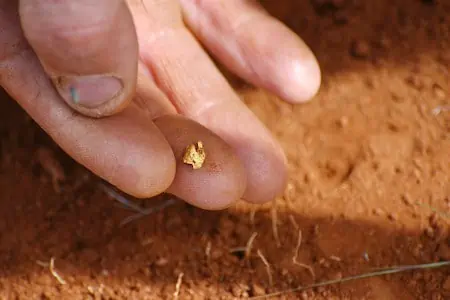
Accessibility is potentially the biggest issue in the East and the West. Many of the Western states were set up for gold prospecting, so mining and staking claims are easier. However, it is important to note that because of this, many areas are still under a claim. When I lived in southwestern Idaho, we would go prospecting in the Boise National Forest. Many locations along the rivers in the area had claims on them. Claim jumping is still a very real thing, and it is your duty to pay attention to these claims. You can be fined heavily for encroaching on someone’s claim.
Regardless of what portion of the country you call home, it is important to remember: look for gold where it has already been found. You can have the best, top of the line, most expensive gold metal detector on the planet, but if gold is not known to exist in the area where you are searching, your fancy machine will not make it magically appear. Do your research on areas known to contain gold near you.
Cheap Metal Detectors for Gold
While it is true, that all metal detectors have the capabilities of finding gold, a very inexpensive metal detector will not find small gold nuggets. They will be fine at finding larger nuggets or larger gold jewelry, but for small nuggets, which are the most found type, you will want a more mid-range gold detector. Gold specific metal detectors, in order to more accurately find gold, should have a frequency of 14 kHz or higher if they are VLF.
Bounty Hunter Gold Digger
The Bounty Hunter Gold Digger is the least expensive metal detector on this list. It is perfect for beginners, especially if you are not sure the hobby will last or if you are on a tight budget. This is a VLF metal detector operating at 6.7 kHz. This is certainly not an ideal frequency for gold prospecting, but that does not mean the machine cannot find gold. It will not find small pieces or exceptionally fine jewelry, however. This is a lightweight machine at just 2.6 pounds. It features trash eliminator control which automatically removes most undesirable items from detection.
The Bounty Hunter Gold Digger features automatic ground tracking, so the detector will adjust itself automatically to ground conditions. Discrimination is adjustable and it features motion all metal mode. The Gold Digger comes standard with an 8” search coil and operates on 2 9-volt batteries. Bounty Hunter offers a 1-year warranty on this detector.
Fisher Gold Bug Pro
The Fisher Gold Bug Pro is a great mid-priced metal detector for gold. This is a VLF metal detector operating at 19 kHz. This detector can find large or small nuggets easily. This detector is lightweight at just 2.5 pounds, so it will not cause a lot of arm fatigue. It comes standard with a 5” Double-D search coil, which can target 2 items simultaneously with good depth. There are 2 other coil options for the Gold Bug Pro: a 7” by 11” elliptical Double-D or a 13” ultimate Double-D (the overall price of the detector varies according to the chosen search coil).
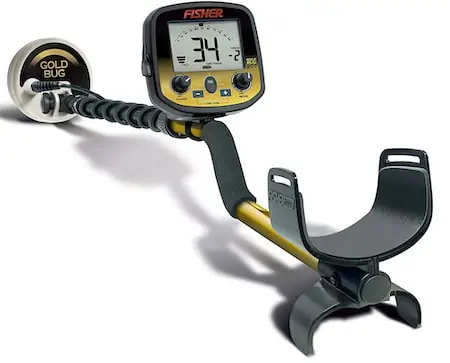
It features dual headphone jacks, VCO (voltage-controlled oscillator), all metal mode, discrimination mode, V-Break tone discrimination, Ground Grab ground balancing, continuous ground condition readout, soil mineralization readout, and pinpoint mode. The Gold Bug Pro operates on a single 9-volt battery.
The Fisher Gold Bug Pro is tailored to intermediate or advanced metal detectorists, so newcomers may struggle slightly with the more complex settings and controls. This detector is great for finding gold nuggets and jewelry. Fisher offers a 5-year warranty on the Gold Bug Pro.
Nokta Makro Au Gold Finder
Nokta Makro’s Au Gold Finder is a fantastic gold prospecting detector. This model operates at 56 kHz, so it is perfect for finding even small nuggets of gold. The Au Gold Finder features automatic, manual, and tracking ground balancing, adjustable sensitivity, adjustable discrimination, audio boost, and 3 search modes: all metal, disc 1 fast, and disc 2 deep. It comes standard with 2 search coils: a 10” by 5.5” waterproof Double-D coil and cover, and a 5” waterproof Double-D search coil and cover. This detector is not fully submersible but is dust and rainproof.
The Au Gold Finder features a visual LED discrimination option that lets you know if your target is ferrous or non-ferrous before you dig. This detector is slightly heavier than others, at 3.3 pounds, but the control box can be hip mounted to reduce arm fatigue with Nokta Makro’s hip mount belt. The Au Gold Finder operates on 4 AA batteries and comes with a 2-year warranty.
Garrett AT Gold
The Garrett AT Gold is a great detector for prospecting. This detector is specifically tuned to find gold and has been in continuous manufacture since 2011. The AT Gold features automatic and manual ground balancing to help prospectors filter out the effects of soil mineralization and hot rocks. The AT gold operates at an adjustable frequency of 18 kHz.
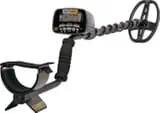
This does not mean the detector has multiple frequency mode, but rather that it can be adjusted slightly to help compensate for soil conditions. This model has 3 search modes: all metal, discriminate, and customizable notch. All metal mode gives users the highest possible sensitivity and depth.
The Garrett AT Gold is lightweight at just 2.8 pounds and operates on 8 AA batteries. It comes standard with an 8” waterproof Double-D search coil. The AT Gold has 8 depth and sensitivity levels, adjustable threshold, 44 discrimination segments, Pro Audio, built-in pinpoint mode, and is fully waterproof up to 10 feet. This model is great for searching in creeks and rivers.
It should be noted that Garrett recommends the AT Gold for use in freshwater only. Saltwater is highly conductive and can make the detector give false readings or even overload. Garrett offers a 2-year warranty on the AT Gold.
Nokta Makro Gold Racer
Nokta Makro’s Gold Racer is built on their RACER technology, which offers users advanced gold prospecting capabilities. This detector operates at 56 kHz, like the Au Gold Finder, and can find the tiniest gold nuggets while ignoring ground conditions and hot rocks. This detector has several advanced technologies: iSAT (Intelligent Self-Adjusting Threshold), iMask (Intelligent Masking), Tone Break, Audio Boost, and superior discrimination. It is ergonomically designed to make this detector versatile and easy to use.
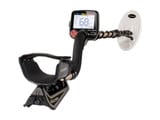
The Gold Racer features an easy-to-read backlit LCD screen and simple to use interface. It also comes with an LED flashlight, pinpoint mode, and depth indicator. The Gold Racer coms with 2 audio frequencies, 3 search modes, 3 types of ground balancing, frequency shift, sensitivity adjustments, numerical target ID, and a waterproof Double-D search coil. This detector weights 3 pounds and operates on 4 AA batteries. Nokta Makro offers a 2-year warranty on the Gold Racer.
Expensive Metal Detectors for gold
Minelab GPX 4500
The Minelab GPX 4500 is an amazing gold prospecting metal detector. IT uses Smart Electronic Timing Alignment (SETA) technology and Minelab’s Multi Period Sensing (MPS) and Dual Voltage Technology (DVT), making it quieter and more immune to interference than other GPX models. The GPX 4500 features several pre-programmed search modes, so this model is great for beginners all the way through expert detectorists. It has good discrimination, iron rejection, and 6 search modes:
- General
- Deep Search
- Hi Mineral
- Hi Trash
- Patch
- Test A
All 6 modes can be modified with user specific settings and renamed. Ground balance off can be used for more neutral soils and for deeper searches. The GPX 4500 comes with a backlight and stabilizer for fine tuning over threshold stability. Target volume and volume limit control prevent signals from being too loud while amplifying softer target signals. Iron rejection allows discrimination of iron rich targets. It features adjustable timings, adjustable audio, adjustable threshold, adjustable sensitivity, and adjustable tune and noise cancel.
The GPX 4500 comes with a rechargeable battery pack with wall charger and vehicle charger for on-the-go capabilities. It is heavier than many detectors, at 5.3 pounds and comes with a 3-year warranty.
Garrett ATX
The Garrett ATX is one of my all-time favorite metal detectors. This is a PI detector and is fantastic for gold or any other type of metal. The ATX is an all-terrain metal detector manufactured with a military style rugged design. Garrett’s PI technology allows for maximum sensitivity on all target types in all conditions. The ATX sends out 730 pulses per second, which is adjustable. The more pulses per second a PI machine sends out, the higher the sensitivity. This detector is great at balancing the effects of saltwater or highly mineralized soils.
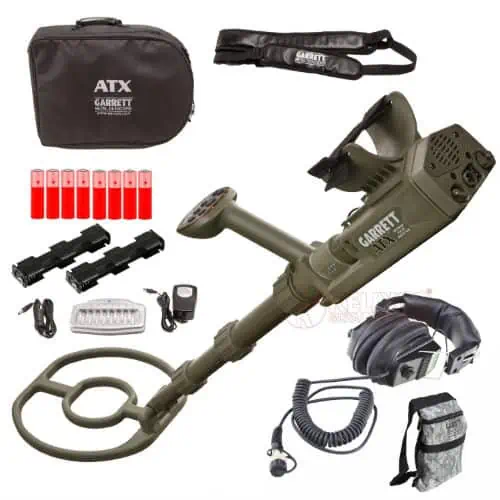
Because this is a PI detector, it is great at finding small, low conductive targets like fine gold. Ground balancing is done with Fast Track technology, so users can quickly and easily compensate for ground mineralization. It has 4 automatic ground balancing settings, too: off, slow, medium, and fast. This reduces the amount of noise from difficult soil conditions. It has a built-in pinpoint mode, adjustable audio threshold, and adjustable sensitivity. It comes with automatic frequency scan to provide quiet operation. Detector noise will occur if electromagnetic interference is too strong. PI machines can search in motion of while still.
The Garrett ATX is quite heavy, at 6.9 pounds, but is fully submersible up to 10 feet. There are 3 search coil options with purchase of the ATX: 10” by 12” open coil, 11” by 13” closed coil, and 11” by 13” mono closed coil. This detector operates on 8 AA batteries and comes with a 2-year warranty.
White’s GMT 24K
White’s Goldmaster 24K is a fantastic gold metal detector. This detector operates at a frequency of 48 kHz. This is high enough to find even the smallest nugget of gold or finest gold jewelry. This machine features a large backlit display with Target Graph. This shows whether the target is ferrous, gold, or high conductor (like silver), and shows these values in a numerical target ID value.
The GMT 24K features White’s XGB ground balancing system, specifically designed to compensate for mineralized soil conditions. It also has TracLock ground balancing and Ground Grab ground balancing. It comes with a feature called Ground Scan which can lead prospectors to paystreaks.
The GMT 24K comes with 10 adjustable sensitivity levels, adjustable audio with 2 boost levels, discrimination, vSAT (variable self-adjusting threshold), adjustable threshold, pinpoint mode, and Tone ID mode. This detector is tailored for all detectorists, so it is simple to use for beginners and features more advanced options for intermediate or advanced detectorists. It is not fully waterproof but is weatherproof.
The GMT 24K comes standard with a 6” by 10” Double-D search coil and uses 8 AA batteries. This detector is heavier than some VLF machines, at 3.6 pounds. White’s offers a 2-year warranty on the GMT 24K. It should be noted that Garrett Metal Detectors recently bought out White’s, so availability and warranty may be subject to change due to this acquisition.
Minelab SDC 2300
The Minelab SDC 2300 is a PI metal detector with Multi Period Fast (MPF) technology. MPF technology incorporates fast pulse induction switching between transmit and receive signals. This allows for clear and sharp detection of even small gold. The SDC 2300 comes with 2 detect modes: normal and salt. Normal mode has 5 sensitivity ranges. Salt mode has 3 sensitivity ranges. Noise cancelling is automatic or manual, ground balancing is automatic, and audio is adjustable. It features adjustable threshold and a 9 LED indicator for detection, battery status, and threshold level.
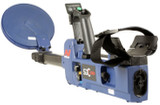
The SDC 2300 weighs 5.1 pounds and operates on a rechargeable battery pack. It comes standard with an 8” round monoloop search coil and is fully waterproof up to 10 feet. When purchased, this model comes with an armrest cover, coil joint protector, and can be paired with optional accessories like waterproof headphones and wireless audio. Minelab offers a 3-year warranty on this model. The SDC 2300 is one of the best metal gold metal detectors.
Finding Gold with a Metal Detector
As mentioned previously, gold is best sought where it has already been found. Some of the best locations to begin your search for gold are dredge tailing piles and placer deposits. Dredge tailings are the remains leftover from previous gold dredging. Placer deposits are composed of sand and gravel within rivers and stream beds.
Gold is carried by stream flow and small amounts can accumulate in various areas within the rivers and streams. You can always search for books that discuss prospecting to get a good idea of where and what to look for. There are also many YouTube videos showing where gold is typically found.
Many states have a Bureau of Mines or Geological Survey that details the occurrences of gold within the state. Always make sure to gather all the laws and rules surrounding gold prospecting in your area, and steer clear of other people’s claims!
KellyCo, a well-known seller of metal detectors and equipment, has a complete guide to prospecting available for anyone to read through. Once you have purchased your desired gold metal detector, the next step is to determine the best settings for your area. As mentioned, many gold bearing locations will have highly mineralized soils and hot rocks. These can trip up even the most advanced detector, so it is important to figure out how to best set up yours. Many feature pre-programmed modes to make it easier for beginners.
I always recommend thoroughly reading through your user manual, then practicing with the detector at home. Find a piece of gold jewelry or nugget, if you have one lying around, and wave it over your detector coil. Become familiar with the sounds the detector emits and the visual cues it gives you.
Now that you have your search area, your metal detector, and your knowledge of what to look for, it is time to start prospecting!
Metal Detecting for Gold Nuggets
While you now know you must find gold where it has already been found (unless you are incredibly lucky), it is important to fine tune that knowledge. Not only do you need to look in a general area where gold was previously discovered, but the exact locations the old-time prospectors found gold. Dry wash piles, tailings piles, dredge piles, and the like, are some of the best locations to find small nuggets.
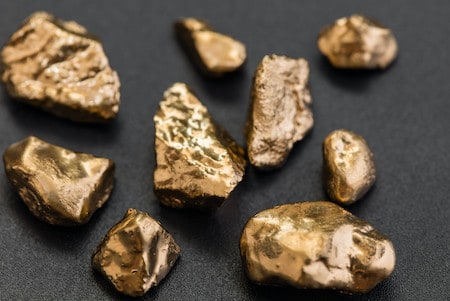
These piles are the left-over residue from previous gold searches, but they are never completely devoid of gold. The old timers were looking for large nuggets and chunks of gold, so odds are, there are small to medium sized nuggets left in their search piles. The odds of finding a huge nugget are slim, but nothing is impossible! Many large nuggets, including the famous nugget at the Golden Nugget in Las Vegas, were found with metal detectors.
One piece of advice is look for lead. I know it sounds silly, but lead is almost indistinguishable from gold in the field. It you are finding small pieces of lead know you are on the right track! This can be especially frustrating if you are in area with a lot of empty bullet casings or birdshot. But, if you can find a small piece of bird shot, you can find a piece of gold. It takes patience and persistence!
Metal Detecting for Gold in Creeks
Gold discovered in creeks and rivers is known as placer gold. Gold is quite heavy, and this makes its movements in water somewhat predictable. It will likely be down below the sand and gravel, in crevices in bedrock. Gold will also travel downstream until it reaches some sort of obstruction, like a crevice in bedrock. It will settle in places where the water slows down or loses the energy necessary to move the gold.
These include deep pools beneath waterfalls, behind large rocks, among exposed tree roots, and inside bends of a stream or creek. To put it in fishing terms, may areas where gold hangs out are where fish would naturally congregate. Look for black sands which settle in the same areas as gold. This does not guarantee gold, but it does improve your chances of finding gold.
When metal detecting in these areas, it is important to have at least a waterproof search coil. I, personally, prefer to have a fully waterproof metal detector, just in case I drop it in the stream. Gold is predictable in streams and creeks. This makes it easier to metal detect as you know where to look. Make sure if the stream or creek bed is very rocky to have a coil cover to avoid damaging your search coil. They can be expensive to replace! Make sure you have chosen a good metal detector, as it will pay off to have one of the best gold metal detectors.
Start by walking the stream and getting a sense of where the inside bends are, where the large boulders are, and the location of any stagnant looking pools or slow-moving pools. Once you have identified your search areas, you can turn on your detector and get prospecting!
FAQ
Q: Do I have to buy an expensive, gold specific metal detector to find gold?
A: No, but it is helpful! All metal detectors possess the ability to find gold. Gold is a low conductive metal, so it can be hard to distinguish from trash targets like iron. Silver and other highly conductive targets are easier to find. But with a gold specific metal detector, the machine has all the necessary programming to make finding gold easier. Many detectorists in the field would choose a gold-specific machine simply because they are built to overcome the problem soils associated with gold fields. So, the answer to this question, is no and yes.
Q: Do I need a permit to search for gold?
A: You will need to search your local and state regulations to find this answer. I live in Utah, where no permit is required. However, there are many stipulations to this. BLM land and US Forest Service lands in Utah are open to prospecting, so long as you are not on someone’s active claim.
There are many restricted areas within my state including national parks and monuments, state parks, Native American reservations, military instillations, wildlife refuges, and wilderness areas. Recreational gold prospecting requires no permit, but recreational dredging does require a permit due to water rights. So, to fully answer this question, you will have to do some research and see if your state requires permits for prospecting.
Q: Are there laws surrounding metal detecting I should know about?
A: Absolutely, yes! There are many laws surrounding metal detecting. You cannot metal detect in any of the places mentioned in the previous question, except BLM (public) lands or Forest Service lands. Private property can be detected on with permission from the owners. Each state, city, and/or county will have its own set of laws regarding detecting. When I lived in southwestern Idaho, we had to have a permit to detect within our city limits. Now that I am back in Utah, this county does not require permits. There are also federal level laws protecting Native American lands and artifacts, or any artifact or building of historical significance. Give your local city a call or search online to see what laws affect you as a detectorist.
If you enjoyed this article, please “like” our Facebook page and be sure to revisit Discover Detecting for new content surrounding the metal detecting hobby!
You Might Also Want to Read:
